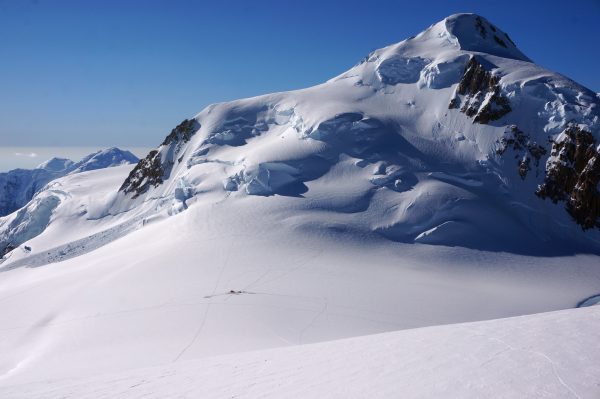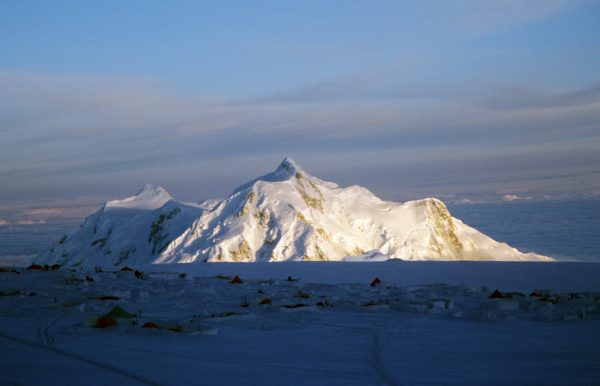Mount Hunter’s record of a colder past
May 25, 2018
Ned Rozell
907-474-7468

For the past century, official thermometers scattered around Alaska have shown a warming trend. Most of the trusted weather stations are in river valleys; Gulkana, at 1,300 feet, is the high point of Alaska’s 21 “first order” weather stations, some of which have been running for a century.
But what about the weather up high? A scientist recently found evidence for even greater warming within the snows of Mount Hunter, sampled at a 13,000-foot saddle. Mount Hunter shoulders up next to Denali and Mount Foraker in Denali National Park.
In 2013, Dom Winski of Dartmouth College spent a few weeks living on Mount Hunter’s high plateau. He and a team from Dartmouth, the University of Maine and the University of New Hampshire twisted a hollow drill bit into ice and snow on top of the mountain.
That summer they pulled out two cores of snow and ice, each in segments that added up to more than 600 feet. They transported all that ice back to a lab in Hanover, New Hampshire.
Those cores showed that snow at two-plus miles elevation is now melting more than at any time since the 1600s. That warming is two times the rate measured at most lower-elevation weather stations in Alaska.
The ice cores that hold the memory of the past are bright white except for striking dark bands. Those rings show when snow on the plateau melted before refreezing in a blue-white place that is usually colder than your freezer.
“Snowmelt on Mount Hunter was a very rare occurrence before the 20th century, with often decades passing with no melt whatsoever,” Winski said. “Today, the majority of summers show some evidence of melting snow.”
Summers up high are now about 3 degrees Fahrenheit warmer than summers during the 1700s, 1800s and the early part of the 1900s. The amount of snowfall that falls now on Mount Hunter is about double what fell there in 1850 and earlier.
Winski thinks the increased warmth and snowfall is linked with a warmer tropical ocean. Jutting 14,573 feet into the atmosphere, Mount Hunter protrudes from the landscape like a giant tooth 100 miles from the ocean. Moisture carried on winds from the Tropics smacks into Mount Hunter, falling out as snow.

Warming in the tropical oceans changes atmospheric circulation patterns across the Pacific Ocean, Winski said. That leads to more moist air flowing northward from the Gulf of Alaska, especially in winter.
“We believe the progressive warming of the oceans is partially responsible for the doubling of snowfall high in the Alaska Range,” he said.
Big melt events happened on Mount Hunter during the summers of 1963, 1982, 1990, 1997, 2002 and 2009. Most of those years were during the early stages of strong El Nino events, during which a blob of warm water forms off the equator in the Pacific Ocean.
Winski’s study on Mount Hunter recently appeared in the Journal of Geophysical Research, published by the American Geophysical Union. He is still working with the cores, which hold ice that fell as snow during the days when the Roman Empire spread all the way from England to the Nile River, about 2,000 years ago.
Since the late 1970s, the University of Alaska Fairbanks' Geophysical Institute has provided this column free in cooperation with the UAF research community. Ned Rozell ned.rozell@alaska.edu is a science writer for the Geophysical Institute.


